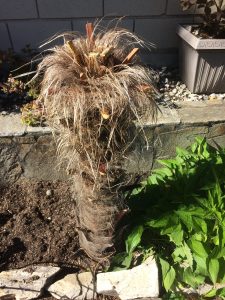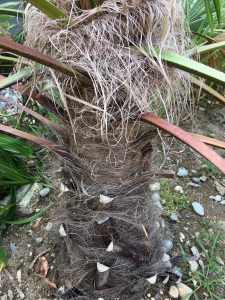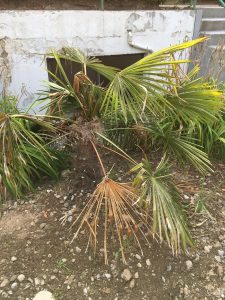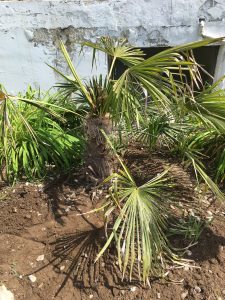I love palms! They remind me of tropical locations we all love to visit. So when the August 2017 issue of Arborist News featured an article on palms, I finished it on the same day. It also gave me one credit towards my recertification.
This blog post features a palm we see in the Vancouver area. I learned about Chinese windmill palms (Trachycarpus fortunei) after they got absolutely hammered this past winter at a client’s place. The lady was clearly distressed because the fronds were all beat up and brown. Plus, her palm was situated near her pool and outdoor kitchen. So I did the only thing I could; I pruned off the brown fronds. When my client retreated into her beautiful home, I snapped a photo of the palm tag and made a reminder to myself to check the species online.

This poor palm didn’t make it. All growth originates from the top and clearly, not much is happening there. But perhaps there is hope. See the next picture.
Winter hardiness
Trachycarpus fortunei is the most tolerant to cold temperatures of all palmate palms. But remember, our last winter in British Columbia was the harshest winter in thirty years. My boss almost lost his juvenile Chinese windmill palm this year. See the second picture above. And it just so happens that my boss and my client both live in an area which held on to snow the longest.
The other complication is that mature Chinese windmill palms handle cold better. Younger specimens are most susceptible.
Details
The Chinese windmill palm is a solitary fan palm with a slender trunk. The key distinguishing feature of this palm is a messy layer of brown fibers that turn gray with age.
The palmate fronds are up to two feet (0.6m) wide and deeply divided into one inch (2.54cm) wide, stiff segments. The petiole is 1.5 feet (0.5m) long and armed along the base with blunt teeth. Yes, the teeth are blunt but weeding around this palm is still unpleasant.
Mature specimens can reach 25 feet (7.6m) in height. This species is a good selection for small gardens.
What palms grow in your home area?
References: Arborist News August 2017 volume 26, number 4, pp. 12-21. This is an excellent article. If you are ISA certified you can earn 1 CEU credit.









